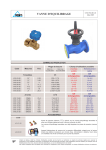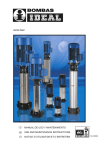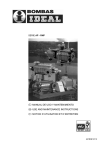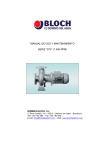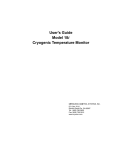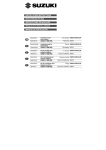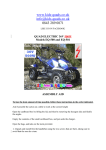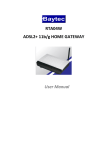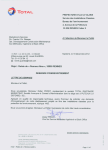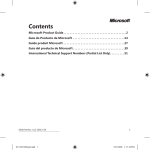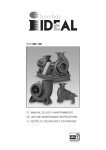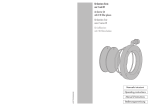Download GNI
Transcript
Bombas Ideal, S.A. indice-index ESPAÑOL...........................................................................................pág 1.- INTRODUCCIÓN 1 2.- DESCRIPCIÓN Y USO 1 3.-IDENTIFICACIÓN 1 4.- GARANTÍA 2 5.- RECEPCIÓN DEL SUMINISTRO 2 6.- MANIPULACIÓN. 2 2 7.- INSTALACIÓN 8.- MONTAJE E INNSTALACIÓN 3 9.- FUNCIONAMIENTO, PUESTA EN MARCHA Y PARO 5 10.- MONTAJE Y DESMONTAJE. 5 11- ANOMALIAS DE FUNCIONAMIENTO 6 ANEXOS 19 ENGLISH………………………………………………………………..…page 1.- INTRODUCTION 7 2.- DESCRIPTION AND USE 7 3.-IDENTIFICATION 7 4.- GUARANTEE 8 5.- RECEPTION OF THE GOODS 8 6.- STORAGE 8 7.- MANIPULATION 8 8.- SET UP AND INSTALLATION 9 9.- RUNNING, STARTING AND STOPPING 11 10.- ASSEMBLY AND DISMANTLING 11 11.- OPERATING ANOMALIES 12 ANNEXS 19 FRANÇAIS…………………………………………………………….……pag 1.- INTRODUCTION 13 2.- DESCRIPTION ET UTILISATION 13 3.-IDENTIFICATION 13 4.- GARANTIE 14 5.- RÉCEPTION DE LA FOURNITURE 14 6.- EMMAGASINAGE 14 7.- MANIPULATION 14 8.- MONTAGE ET INSTALLATION 15 9.- FONCTIONNEMENT, MISE EN MARCHE ET ARRÊT 17 10.- MONTAGE ET DÉMONTAGE. 17 11.- ANOMALIES DE FONCTIONNEMENT 18 ANNEXES 19 1 Bombas Ideal, S.A. 1.- INTRODUCCIÓN Este manual de servicio está dirigido a los usuarios de grupos tipo GNI Contiene las instrucciones de instalación, servicio y mantenimiento. Antes de proceder a cualquier tipo de intervención, el usuario debe leer atentamente este manual y prestar atención a cuantas sugerencias y recomendaciones se den en él, especialmente las que sean precedidas de los siguientes símbolos de seguridad: La no observancia de estas instrucciones, puede exponer a las personas a riesgos importantes para su salud. La no observancia de estas instrucciones, puede exponer a las personas a riesgos de origen eléctrico. ATENCIÓN Las instrucciones identificadas con este mensaje, indican su importancia para una correcta instalación, utilización y mantenimiento. Con el objeto de mejorar el resultado final de sus productos, Bombas Ideal S.A. se reserva el derecho de modificar el contenido del presente manual y/o el propio producto sin necesidad de avisar previamente a sus clientes. El incumplimiento de las sugerencias y recomendaciones de este manual, así como la incorrecta utilización o la manipulación no autorizada del producto, invalida totalmente la responsabilidad de Bombas Ideal S.A., por los posibles daños causados, ya sean personales o materiales. El manual se suministra junto con la bomba y debe estar próximo al lugar de la instalación, debidamente protegido, para que pueda ser consultado por los usuarios en caso de necesidad. 2.- DESCRIPCIÓN Y USO Grupo monobloc con bomba normalizada según DIN 24255 acoplada a un motor estándar. Cuerpo de bomba, soporte y rodete en hierro fundido y eje en acero inoxidable. Cierre mecánico de grafito-cerámica normalizado según DIN 24960. Temperatura máxima del liquido bombeado: 100ºC. Temperatura máxima ambiente: 40ºC. Presión máxima 10 bars. Los grupos GNI son adecuados para elevación y trasiego de líquidos en industrias, instalaciones de riego, minas, construcción, abastecimiento de poblaciones, instalaciones de aire acondicionado, equipos contra-incendios, etc. En ningún caso: Se ubicarán en locales clasificados con riesgo de explosión. Se utilizarán para el trasiego de líquidos inflamables. Bajo pedido, se pueden suministrar con configuraciones especiales, capaces de bombear distintos tipos de líquidos y temperaturas hasta un máximo de 160º C 3.-IDENTIFICACIÓN Los grupos GNI Incorporan una placa metálica en la que se indican los datos siguientes: TIPO: identificación del modelo de grupo y número de fabricación. Potencia (CV/Kw), tensión (V)., intensidad (A), velocidad (RPM) y frecuencia (Hz). Bombas Ideal, S.A. 2 4.- GARANTÍA Bombas Ideal S.A., garantiza los grupos GNI, por un período de 12 meses desde la fecha de entrega, contra todo defecto de materiales y de fabricación, de acuerdo con lo indicado en sus condiciones generales de venta. El incumplimiento de las sugerencias y recomendaciones de este manual, así como la incorrecta utilización o la manipulación no autorizada del producto, invalida totalmente la garantía. La garantía excluye el desgaste por uso, la utilización incorrecta, la reparación o sustitución de la pieza defectuosa por el usuario o por personal no cualificado sin la autorización expresa de Bombas Ideal S.A. 5.- RECEPCIÓN DEL SUMINISTRO A la recepción del suministro se debe verificar que: • • • • El embalaje no ha sufrido deterioro durante el transporte. En caso contrario efectuar inmediatamente la correspondiente reclamación al transportista. El material suministrado coincide con las especificaciones del pedido. El material no ha sufrido ningún daño durante el transporte. Junto con el material se incluye el Manual Técnico. ATENCIÓN: Cualquier anomalía detectada debe ser comunicada de forma inmediata a Bombas Ideal S.A. 6.- ALMACENAMIENTO Los grupos se almacenarán en zonas aireadas y exentas de humedades. Si el tiempo de permanencia en almacén es mas prolongado, se tomarán las precauciones necesarias para evitar la corrosión de la bomba mediante el empleo de un producto anticorrosivo, procediendo además al cierre de los orificios de aspiración e impulsión. ATENCIÓN Asegurar que el motor no sea expuesto a agentes atmosféricos, no compatibles con su grado de protección, que puedan producirle daños. Antes de almacenar una bomba que recientemente ha sido instalada deberemos proceder a su limpieza y posterior secado. 7.- MANIPULACIÓN. Para la manipulación de los equipos se han de utilizar sistemas de elevación y transporte adecuados y conformes con las normativas de seguridad. Utilizar una eslinga de manera que se asegure la estabilidad durante la elevación y desplazamiento 3 Bombas Ideal, S.A. 8.- MONTAJE E INSTALACIÓN El lugar de emplazamiento de la bomba se situará lo mas cerca posible del nivel del líquido evitando así tuberías de aspiración demasiado largas. Su posición responderá al criterio de que el NPSHd sea siempre superior al NPSHr de la bomba. Para el correcto funcionamiento de la bomba, debemos tener en cuenta que el trazado y dimensionado de la tubería de aspiración reúna los siguientes requisitos: 1. La tubería de aspiración debe ser corta, con el menor número de codos y estos de gran radio de curvatura. El ultimo tramo antes de la bomba debe ser recto. 2. El diámetro ha de ser de 1,5 a 2 veces el paso de la brida de aspiración de la bomba. 3. El cono de entrada debe ser excéntrico cuando la bomba trabaje con depresión. Si trabaja en carga este cono puede ser concéntrico. 4. La tubería será ascendente hacia la bomba, con una inclinación de un 2% como mínimo. 5. Sea hermética a la entrada de aire. 6. Cuando la bomba trabaje en depresión y con objeto de poder cebarla, deberá llevar una válvula de pie adecuada y colocada a la profundidad necesaria (sumergencia) para evitar la toma de aire por la formación de vórtices. La tubería de impulsión debe reunir los requisitos siguientes: 1. 2. 3. 4. Sea hermética. Dimensiones adecuadas para no causar excesivas pérdidas de carga. Disponer de válvula reguladora a la salida de la bomba. En los casos que sea necesario, se debe instalar una válvula de retención entre la bomba y la válvula de regulación así como los dispositivos adecuados tendentes a eliminar los efectos nocivos de posibles golpes de ariete. ATENCIÓN Las tuberías deben apoyarse en soportes cercanos al cuerpo de bomba de manera que no transmitan ninguna tensión a las bridas de la bomba. 7 6 8 5 4 3 2 1 1. Válvula de pie con colador 2. Codo de gran radio 3. Tubería ascendente. Inclinación mínima 2% 4. Cono excéntrico 5. Tapón de desaireación 6. Válvula de retención 7. Válvula de regulación 8. Tubería de impulsión 4 Bombas Ideal, S.A. 8.1- Conexiones eléctricas. Las conexiones eléctricas se deben realizar por personal cualificado. Antes de realizar el conexionado de los motores , comprobar que las partes eléctricas en las que operaremos no están conectadas con la red de alimentación. Los cables de tierra (color amarillo-verde) deben conectarse al circuito de tierra de la instalación antes de conectar los restantes conductores. Las figuras muestran la correcta conexión para el caso de arranque directo y línea trifásica con tensión de red 230 voltios y 400 voltios. CONEXIÓN TRIÁNGULO Z U X V 230/400v motor 400/690v CONEXIÓN ESTRELLA Y W 230v red 400v Z U X V motor 230/400v Y W red 400v ARRANQUE Y/∆. Quitar las plaquitas puente de la caja de bornes y conectar los bornes del motor con los correspondientes del arrancador. Tensión de alimentación ATENCIÓN Controlar que los valores de la tensión y la frecuencia de la red de alimentación, coinciden con los indicados en la placa de características del motor, según sea la conexión estrella o triangulo. Bombas Ideal, S.A. 5 9.- FUNCIONAMIENTO, PUESTA EN MARCHA Y PARO El funcionamiento de los grupos GNI es simple y seguro. No se debe utilizar un grupo para un servicio distinto para el cual ha sido diseñado. 9.1.- Puesta en Marcha. Antes de la puesta en marcha se tendrán en cuenta las siguientes indicaciones: -Comprobar el perfecto cebado de la bomba y tubería, el fluido debe desbordar la instalación para garantizar que se ha eliminado el aire, especialmente el contenido en la tubería de aspiración. -Verificar que el voltaje de la red coincide con el indicado en la placa de características. -Comprobar el correcto conexionado de la placa de bornas del motor. -Verificar que el sentido de giro es coincidente con el indicado por la flecha que está situada en el cuerpo de bomba. -Controlar que la corriente absorbida (consumo en amperios) no supere los valores indicados en la placa de características del motor. -Ajustar la protección de sobrecarga en el cuadro de mando. El funcionamiento de las bombas centrífugas es sencillo y seguro no requiriendo un control exhaustivo, no obstante para garantizar una correcta funcionalidad es importante tener en cuenta tanto en el primer momento del arranque como después de un período prolongado de funcionamiento las siguientes indicaciones: El funcionamiento debe ser silencioso y exento de vibraciones. Verificar que el caudal y la presión de servicio se corresponden con los determinados en los campos de trabajo Controlar que la corriente absorbida no supere los valores indicados en la placa de características del motor. Para períodos largos de parada de los equipos, se debe vaciar por completo la bomba y las tuberías, para evitar los riesgos de helada durante el invierno y la posible oxidación de los elementos mecánicos que se pueda originar por el líquido estancado. 10.- MONTAJE Y DESMONTAJE. En el caso de que sea necesario desmontar el grupo para realizar alguna operación de mantenimiento o reparación se procederá de acuerdo con lo descrito a continuación. Generalmente el cuerpo de bomba nº 379 no requiere intervención, por lo que quedará unido a las tuberías de aspiración e impulsión. En primer lugar procederemos al vaciado del líquido contenido en las tuberías y en el cuerpo de bomba. Tapón nº 42. Soltar a continuación las tuercas nº 95-96 que fijan la tapa cuerpo nº 812 al cuerpo de bomba nº 379 De esta manera se desmontará el conjunto formado por el motor nº 1001 con la tapa cuerpo nº 812 y el rodete nº 726. Para separar el rodete nº 726 del conjunto, aflojar la tuerca sujeción rodete nº 828. Desmontar el cierre mecánico nº 63, parte giratoria. Después de reparar o sustituir las piezas defectuosas se procederá al montaje de la bomba procediendo de manera inversa a lo descrito en este apartado. 6 Bombas Ideal, S.A. 11- ANOMALIAS DE FUNCIONAMIENTO ANOMALIA CAUSA REMEDIO 1. Bomba no eleva agua. 1.1. Giro en sentido inverso. Cambio conexiones motor eléctrico. 1.2. Bomba no cebada. Válvula de pie pierde. Pérdidas en juntas o tubería de aspiración. Revisar estos elementos. Averiguar el motivo que provoca esa baja velocidad (consumo excesivo o frecuencia baja). Acercar la bomba al nivel del agua Reducir pérdidas en la tubería de aspiración. Probar a presión, la tubería de aspiración, incluyendo la bomba y observar cualquier escape de líquido. Prolongar la tubería de aspiración aumentando la sumergencia. Limpiar la válvula. 1.3. Baja velocidad de giro. 1.4. Altura de aspiración muy alta. 1.5. Toma de aire en tubo de aspiración. 1.6. Poca sumergencia. 2. Caudal insuficiente 2.1. Válvula de pie parcialmente obstruida. 2.2. Poca sumergencia. 2.3. Bolsas de aire en aspiración. 2.4. Sentido de giro cambiado. 2.5. Desgaste de piezas internas. 3. La potencia absorbida es 3.1. Peso específico y viscosidad superior a la prevista. superiores a los previstos. 3.2 . Demasiado consumo. 4. La bomba se desceba 4.1 Excesiva altura de aspiración. después de arrancar. 4.2 Toma de aire en aspiración. 5 -Bomba vibra. 5.1. Desequilibrio del rodete por rotura u obstrucción parcial. 5.2 Cavitación. Sumergir mas la válvula de pie. Reducir el caudal. Cambiar disposición de la tubería. Disponer de llaves de purga de aire. Cambio conexiones motor eléctrico. Cambiar las piezas desgastadas. Reducir caudal con la válvula reguladora o cambiar motor. Comprobar abroche bornes. Verificar la tensión de red y que el eje gira suave a mano. Acercar la bomba al nivel del agua Reducir pérdidas en la tubería de aspiración. Probar a presión, la tubería de aspiración, incluyendo la bomba y observar cualquier escape de líquido. Cambiar rodete, limpiar rodete. Cambiar las condiciones de trabajo de la bomba en la instalación. Consultar con nuestro servicio técnico. 7 Bombas Ideal, S.A. 1.- INTRODUCTION This service manual is intended for users of type GNI horizontal pumps. It contains the instructions for installation, service and maintenance. Before proceeding to do any kind of work on the equipment, users should read this manual carefully and pay attention to any suggestions and tips given in it, particularly the ones preceded by the following safety symbols: Failure to observe these instructions may expose people to serious danger for their health. Failure to observe these instructions may expose people to electrical risks. TAKE NOTE Any instructions preceded by this message are of great importance for proper installation, use and maintenance. In order to improve the final result of its products, Bombas Ideal S.A. reserves the right to modify the content of this manual and/or the product itself with no need to inform its customers beforehand. Failure to comply with the suggestions and recommendations in this manual, as well as improper use or non-authorised handling of the product, shall fully release Bombas Ideal S.A. from any liability as regards possible damage caused, whether this be personal or material. The manual is supplied along with the pump and should be kept close to the point of installation, duly protected so that this can be consulted by users when required. 2.- DESCRIPTION AND USE Close coupled pumps standardized according to DIN 24255 close coupled to standard motor. Pump casing, support and impeller in cast iron and shaft in stainless steel. Mechanical seal in carbonceramic standardized according to DIN 24960. Maximum liquid temperature 100ºC. Maximum ambient temperature 40ºC. Maximum pressure 10 bar. GNI pumps are appropriate for lifting and moving liquids in industries, irrigation systems, mines, building, urban supply, air conditioning installations, fire-fighting equipment, etc. Do not under any circumstances: • • Locate the systems in premises classified as involving an explosion risk. Use these for moving inflammable liquids. Upon request, special configurations can be supplied for different liquids and temperatures up to 160º C. 3.-IDENTIFICATION GNI pumps have a metal plate on which the following data is stated: TYPE: identification of the pump model. and nº : manufacturing number. Power (CV/Kw), winding (volts), rated current (A), speed (RPM), frequency (Hz). Bombas Ideal, S.A. 8 4.- GUARANTEE Pumps from Bombas Ideal S.A., have a guarantee period of 12 months from delivery date, against any flaw in materials and manufacture, according to the general sales terms. Failure to comply with the suggestions and recommendations in this manual, as well as any improper use or non-authorised handling of the product, will completely invalidate the guarantee. The guarantee excludes wear and tear through use, improper use, repair or replacement of the faulty part by the user or by unqualified staff without the express consent of Bombas Ideal S.A. 5.- RECEPTION OF THE GOODS On reception of the goods please check that: • • • • The packaging has not undergone any damage during transport. Otherwise immediately make the relevant claim to the forwarder. The material supplied coincides with the order specifications. The material has not undergone any damage during transport. The Technical Manual is included with the material. TAKE NOTE Bombas Ideal S.A. should immediately be informed of any anomaly found 6.- STORAGE The pumps should be stored in well-ventilated zones free of damp. For short storage periods the machined parts should be protected with an oil or anti-corrosion product. If the pump is to be left for longer periods in the store, precautions should be taken to prevent the pump from corroding by using an anti-corrosion product, also proceeding to cover up the suction and delivery flanges. Turn the shaft by hand every 15 days to prevent any possible seizing up. TAKE NOTE Make sure that the diesel engine or electric motor is not exposed to atmospheric agents not compatible with its degree of protection which might cause damage to this. Before storing a pump, which has recently been installed, proceed to clean and then air-dry it (do not used hydrocarbide-based products). 7.- MANIPULATION For handling the equipment appropriate lifting and transport systems complying with safety norms should be used. To handle the motor pump set use a sling going under pump and motor to ensure stability during lifting and displacement. 9 Bombas Ideal, S.A. 8.- SET UP AND INSTALLATION The site for placing the pump should be as close as possible to the liquid level, thus avoiding excessively long suction piping. Its position must meet the criterium that NPSHd is higher than the NPSHr of the pump. For the pump to run properly, take into account that the layout and dimensional design of the suction piping should meet the following requisites: 7. The suction piping should be short, with as few bends as possible, any such bends to have a wide curve radius, the last section before the pump must be straight. 8. The diameter must be 1.5 to 2 times the diameter of the pump’s suction flange. 9. The inlet cone must be eccentric when the pump works under depression. If it works under load this cone can be concentric. 10. The piping should be upwards towards the pump, with a slope of at least 2%. 11. It must be properly sealed, preventing the admission of air. 12. When the pump has negative suction, in order to prime it, it should have a suitable foot valve placed at the required depth (submergence) to prevent air intake through vortices forming. The delivery piping must meet the following requisites: 5. 6. 7. 8. TAKE CARE Being sealed. Having the proper dimensions to avoid excessive head losses. Having a delivery valve at the outlet of the pump. Where necessary, a non-return valve should be installed between the pump and the delivery valve as well as the appropriate devices tending to eliminate the harmful effects of any possible water hammers. the pipes should be held on supports close to the body of the pump so that they do not transmit any stresses on the pump flanges. 7 6 8 5 4 3 2 1 1. Foot valve with strainer 2. Elbow of large radio 3. Rising pipe. Inclination minimun 2% 4. Eccentric cone 5. Vent plug 6. Non return valve 7. Delivery valve 8. Delivery pipe 10 Bombas Ideal, S.A. 8.1- Electrical connections. Qualified staff should make electrical connections. Before making the motor connections, check that the electrical parts on which you are going to work are not connected to the power supply. The ground cables (yellow/green) should be connected to the ground circuit of the system before connecting up the other conductors. The figures show the proper connection for the case of direct starting and three-phase line with 230 volts and 400 volts mains voltage. DELTA CONNECTION Z U X V 230/400v motor 400/690v STAR CONNECTION Y W 230v line 400v Z U X V motor 230/400v Y W line 400v Y/∆ STARTING. Remove the bridge plates from the terminal box and connect the motor terminals to the corresponding ones on the starter. Supply voltage TAKE CARE Check that the values for the voltage and frequency of the supply mains coincide with the ones indicated on the motor characteristics plate, depending on whether this is star or delta connection. Bombas Ideal, S.A. 11 9.- RUNNING, STARTING AND STOPPING The operation of centrifugal pumps as GNI a simple and safe matter. Pump should not be used for any purpose other than the one it was prepared for. 9.1.- Starting up. Before starting up the following points should be taken into account: -Check the proper priming of the pump and pipelines, as the fluid should overflow the system to ensure that all the air has been vented, especially any contained in the suction piping. -Make sure that the sense of rotation coincides with the direction of the arrow located on the pump body. Centrifugal pumps performance is simple and safe and does not require any exhaustive checking, though to guarantee proper operation it is important to take the following points into account both the first time this is started up and after a long period running: Operation should be silent and vibration-free. Check that the flow and service pressure match what is determined in the work fields (see the relevant technical documentation from Bombas Ideal S.A.). Check that the input current (consumption in amperes) is not over the values stated in the motor characteristics plate. When the equipment is to be idle for long periods, the pump and piping should be completely drained, to prevent the risks of frost during the winter and any possible rusting of the mechanical items that might be caused through trapped liquid 10.- ASSEMBLY AND DISMANTLING If the pump needs to be dismantled to carry out any maintenance or repairing, proceed as described below. It is quite often that pump casing nº 379 does not need any repairing, so it can be left on site, connected to suction and delivery pipes. Drain all the liquid from the pipelines and pump casing by removing the pump drain plug nº 42. Loose screws nº 95-96 that secure the casing cover nº 812 to pump casing nº379; You can then dismantle the sub-assembly consisting of the motor nº 1001 with the casing cover nº 812 and the impeller nº 726. To disassemble the impeller nº 726, loose the impeller nut nº 828. Then dismantle the rotary part of the mechanical seal nº 63. When the screws nº 51 that fix the casing cover nº 812 to the motor nº 1001 have been released proceed to dismantle the stationary seal ring nº 63. After repairing or replacing the faulty parts you can proceed to assemble the pump proceeding as stated in this section, inversely. 12 Bombas Ideal, S.A. 11.- OPERATING ANOMALIES ANOMALY CAUSE 1. The pump does not lift 1.1. Rotating the wrong way. water. 1.2. Pump not primed. 4. 5. Foot valve leaking. Leaks in gaskets or suction piping. Check these parts. 1.3. Low rotating speed. Check the reason for this low speed (excessive consumption or low frequency). 1.4. Suction head too high. Take the pump closer to the water level. Change the pump for another with less NPSHr. Reduce leaks in the suction piping. 1.5. Air getting into suction pipe. Test pressure the suction pipeline, including the pump and observe any liquid leak. 1.6. Insufficient submergence. Extend the suction pipeline increasing the submergence. Insufficient flow 2.1. Foot valve partially blocked. Clean. 2.2. Insufficient submergence. Submerge the foot valve more. Reduce the flow. 2.3. Air pockets in suction line. Change the arrangement of the pipeline. Use air drain keys. 2.4. Rotating direction changed. Change connections of electric motor 2.5. Internal parts worn. Change the worn parts. The power consumption 3.1 Specific gravity and viscosity Reduce the flow with the delivery valve or is higher than expected. over what is expected. change the motor. 3.2. Excessive consumption. 6. 7. 8. SOLUTION Change connections of electric motor.. Check the fastening of the terminals. Check the mains voltage and make sure the shaft turns gently by hand. The pump drains after 4.1 Excessive suction head. Take the pump closer to the water level. starting. Change the pump for another with less NPSHr. Reduce leaks in the suction piping 4.2. Air taking through the suction Test pressure the suction pipeline, including line. the pump and observe any liquid leak 4.3. NPSHr < NPSHd Reduce the NPSHr of the pump, increase the NPSHd of the system, enquire at technical service. The pump vibrates. 5.1. Impeller imbalanced through Change the impeller, clean the impeller. breakage or partial obstruction. 5.2. Air in the liquid. Bleed the air from the liquid or prevent it from getting into the pump. 5.3. Cavitation. Change the operating conditions of the pump in the installation. Enquire at our technical service. The bearings get too hot. 6.1. The pipelines produce tensions in Eliminate the tensions by loosening the the pump. pipeline. 13 Bombas Ideal, S.A. 1.- INTRODUCTION Ce manuel technique s'adresse aux usagers de pompes horizontales types GNI. Il contient les instructions d'installation, de fonctionnement et d'entretien. Avant toute intervention sur l'équipement, l'usager doit lire attentivement ce manuel et suivre tous les conseils et recommandations qu'il contient, en particulier celles précédées des symboles de sécurité suivantes : Le non-respect de ces instructions peut entraîner des risques importants pour l'intégrité des personnes. Le non-respect de ces instructions peut entraîner des risques de danger électrique pour les personnes. ATTENTION Les instructions apparaissant après ce message indiquent qu'elles sont importantes pour l'installation, l'utilisation et l'entretien adéquats de l'équipement. Dans le but d'améliorer les performances de ses produits, Bombas Ideal S.A. se réserve le droit de modifier le contenu du présent manuel et/ou le produit lui-même, et cela sans avoir à en aviser préalablement les clients. Le non-respect des conseils et recommandations contenues dans ce manuel, de même qu’une mauvaise utilisation ou la manipulation non autorisée du produit, dégage automatiquement Bombas Ideal S.A. de toute responsabilité face aux possibles dommages causés, qu'ils soient matériels ou personnels. Nos pompes sont livrées avec le manuel et celui ci doit toujours rester à proximité du lieu d'installation, dûment protégé afin de pouvoir être consulté à tout moment par les usagers en cas de besoin. 2.- DESCRIPTION ET UTILISATION Groupe monobloc avec pompe normalisé d’après la norme DIN 24255 accouplée à un moteur standard.. Corps de pompe, support et roue en fonte, arbre en acier inox. Garniture mécanique de carbone-céramique normalisée d’après norme DIN 24960. Température maximum du liquide 100ºC. Pression maximum 10 bar. Les pompes GNI son adaptées pour élévation et dépotage de liquides dans les industries, les installations d'irrigation, mines, la construction, l'approvisionnement urbain, installations d'air conditionné, équipements incendies, etc. Avertissement : • • Les pompes ne doivent jamais être installées dans locaux où il y a risque d'explosion. Les pompes ne doivent jamais être utilisées pour le dépotage de liquides inflammables. Les pompes sont aussi disponibles sur commande avec configurations spéciales capables de pomper différents types de liquides et à des températures allant jusqu'à 160º C.maximum. 3.-IDENTIFICATION Les pompes GNI possèdent une plaque métallique où figurent les indications suivantes : TYPE : identification du modèle de pompe et numéro de fabrication. Puissance (CV/Kw), tension d’alimentation (V), intensité (A), vitesse (RPM), fréquence (Hz). Bombas Ideal, S.A. 14 4.- GARANTIE Suivant les termes figurant dans ses conditions générales de vente, Bombas Ideal S.A., garantit les pompes GNI contre tous les défauts de matériels et de fabrication pour une période de 12 mois à compter de la date de livraison. Le non-respect des conseils et recommandations contenues dans ce manuel ainsi que la mauvaise utilisation ou la manipulation non autorisée du produit invalide totalement la garantie. La garantie exclut l'usure pour utilisation, l'utilisation incorrecte et la réparation ou le remplacement des pièces défectueuses par l'usager lui-même ou par du personnel non qualifié sans l'autorisation expresse de Bombas Ideal S.A. 5.- RÉCEPTION DE LA FOURNITURE A la réception de la fourniture, il y a lieu de vérifier que : • • • • L'emballage n'a pas subi de dommages pendant le transport. Dans le cas contraire, adresser la réclamation correspondante au transporteur. Le matériel livré correspond bien aux spécifications de la commande. Le matériel n'a subi aucun dommage pendant le transport. Le Manuel technique est livré avec le matériel. ATTENTION Toute anomalie détectée doit être communiquée immédiatement à Bombas Ideal S.A. 6.- EMMAGASINAGE Les pompes seront emmagasinées dans des zones aérées et non humides. Si la durée de stockage doit se prolonger, il faudra prendre toutes les mesures nécessaires en vue d'éviter la corrosion de la pompe, en particulier l'usage d'un produit anticorrosif et la fermeture des orifices d'aspiration et de refoulement. ATTENTION S'assurer que le moteur thermique ou électrique n'est pas exposé aux agents atmosphériques non compatibles avec son degré de protection et pouvant l'endommager. Avant d'emmagasiner une pompe récemment installée, il faut la nettoyer (sans utiliser de produits dérivés d'hydrocarbures) et la sécher au jet d'air. 7.- MANIPULATION Pour la manipulation des équipements il faut utiliser des systèmes de levage et de transport adaptés et conformes aux normes de sécurité. 15 Bombas Ideal, S.A. 8.- MONTAGE ET INSTALLATION Le lieu d'emplacement de la pompe sera le plus près possible du niveau du liquide, ceci dans le but d'éviter des tuyauteries d'aspiration trop longues. Sa position répondra au critère voulant que le NPSHd doit toujours être supérieur au NPSHr de la pompe. Pour le bon fonctionnement de la pompe, le tracé et les dimensions de la tuyauterie d'aspiration doivent remplir les conditions suivantes : 13. La tuyauterie d'aspiration doit être courte, avec le moins de coudes possibles et ceux-ci devant avoir un grand rayon de courbature. Le dernier segment avant la pompe doit être droit. 14. Le diamètre doit être 1,5 à 2 fois le pas de la bride d'aspiration de la pompe. 15. Le cône d'entrée doit être excentrique lorsque la pompe travaille en dépression. Si elle travaille en charge, ce cône peut être concentrique. 16. La tuyauterie sera ascendante vers la pompe, avec une inclinaison de 2% minimum. 17. Elle sera hermétique à l'entrée d'air. 18. Pour amorcer la pompe lorsque celle-ci travaille en dépression, il faut disposer d'un clapet de pied adéquat et placé à la profondeur nécessaire (submergence) afin d'éviter la prise d'air par la formation de tourbillons. La tuyauterie de refoulement doit remplir les conditions suivantes : 9. 10. 11. 12. Être hermétique. Avoir des dimensions adéquates pour ne pas causer de pertes de charge excessives. Disposer d'une vanne de réglage à la sortie de la pompe. Au besoin, il faut installer un clapet de retenue entre la pompe et la vanne de réglage ainsi que les dispositifs adéquats pour éliminer les effets négatifs d'éventuels coups de bélier. ATTENTION Les tuyauteries doivent reposer sur des supports situés à proximité du corps de la pompe de manière à ne pas transmettre de tension aux brides de la pompe. 7 6 8 5 4 3 2 1 1. Clapet de pied avec crépine 2. Coude au grand rayon 3. Tuyauterie ascendante. Inclinaison minimum 2% 4. Cône excentrique 5. Bouchon de purge 6. Soupape de retenue 7. Vanne de réglage 8. Tuyauterie de refoulement 16 Bombas Ideal, S.A. 8.1- Connexions électriques. Les connexions électriques doivent être effectuées par du personnel qualifié. Avant d'effectuer les connexions des moteurs, vérifier que les parties électriques où l'on travaille ne sont pas branchées au réseau d'alimentation. Les câbles de terre (en jaune et vert) doivent être branchés au circuit de terre de l'installation avant de connecter les autres conducteurs. Les figures ci-dessous indiquent la bonne connexion pour un démarrage direct et ligne triphasée avec tension de réseau 230 volts et 400 volts. CONNEXION TRIANGLE Z U X V CONNEXION ÉTOILE Y W 230v 230/400v moteur 400/690v réseau 400v Z U X V Y W moteur 230/400v réseau 400v DÉMARRAGE Y/∆. Enlever les plaquettes pont de la boîte à bornes et connecter les bornes du moteur avec les bornes correspondantes du démarreur. Tension d'alimentation ATTENTION Contrôler que les valeurs de la tension et la fréquence du réseau d'alimentation coïncident avec celles indiquées sur la plaque de caractéristiques du moteur, en fonction du type de connexion, étoile ou triangle. Bombas Ideal, S.A. 17 9.- FONCTIONNEMENT, MISE EN MARCHE ET ARRÊT Le fonctionnement des pompes centrifuges du type GNI est simple et sûr. Il est interdit d'utiliser une pompe pour un fonctionnement autre que celui pour lequel elle a été proposée. 9.1.- Mise en Marche. Avant de mettre l'équipement en marche, suivre les indications suivantes : -Vérifier le bon amorçage de la pompe et de la tuyauterie, le fluide doit déborder l'installation pour garantir que l'air a été purgé, en particulier celui contenu dans la tuyauterie d'aspiration. -Contrôler la bonne connexion de les plaquettes pont de la boîte à bornes et que les valeurs de la tension et la fréquence du réseau d'alimentation coïncident avec celles indiquées sur la plaque de caractéristiques du moteur. -Vérifier manuellement que l'arbre tourne facilement sans effort. -Vérifier que le sens de rotation est le mème que celui indiqué par une flèche sur le corps de pompe. Le fonctionnement des pompes centrifuges est simple et sûr et n'a pas besoin d'être contrôlé exhaustivement, néanmoins et pour garantir leur fonctionnement correct, il est important de suivre les indications suivantes, dès le premier démarrage et après une période prolongée de fonctionnement : Le fonctionnement doit être silencieux et ne pas provoquer de vibrations. Vérifier que le débit et la pression de fonctionnement correspondent avec ceux déterminés dans les champs de travail. Contrôler que la puissance absorbée (consommation en ampères) ne dépasse pas les valeurs indiquées sur la plaque signalétique du moteur. Lors de périodes d'arrêt prolongées des équipements, vider entièrement la pompe et les tuyauteries afin d'éviter les risques de gel pendant l'hiver et la possible oxydation des éléments mécaniques à cause du liquide restant. 10.- MONTAGE ET DÉMONTAGE. Au cas où il serait nécessaire de démonter la pompe pour effectuer une opération d'entretien ou de réparation, suivre le procédé suivant : Généralement le corps de pompe nº 379 ne précise aucune intervention, et donc il restera uni aux tuyauteries d'aspiration et de refoulement. En premier lieu, il faut vider le liquide contenu dans les tuyauteries et dans le corps de la pompe en desserrant le bouchon vidange pompe nº 42. Enlever les écrous nº 95-96 fixant le couvercle du corps nº 812 au corps de pompe nº 379. Ainsi on démonte l'ensemble formé par le moteur nº 1001 avec le couvercle corps nº 812 et la roue nº 726. Pour séparer la roue nº 726 de l'ensemble, desserrer l’écrou de la roue nº 828. Démonter la garniture mécanique nº 63 côté tournant. Après avoir réparé ou changé les pièces défectueuses, procéder au montage de la pompe en suivant le procédé inverse à celui décrit ci-dessus. 18 Bombas Ideal, S.A. 11.- ANOMALIES DE FONCTIONNEMENT ANOMALIE CAUSE 1. La pompe n'élève pas l'eau. 1.1. Rotation en sens inverse. SOLUTION Changement des connexions du moteur électrique. Changement de la position du moteur d'explosion. 1.2. La pompe n'est pas amorcée. Le clapet de pied perd. Pertes aux joints ou dans la tuyauterie d'aspiration. Réviser ces éléments. 1.3. Faible vitesse de rotation. Vérifier la raison provoquant cette faible vitesse (consommation excessive ou basse fréquence). 1.4. Hauteur d'aspiration très élevée. Approcher la pompe du niveau d'eau Réduire les pertes de charge dans la tuyauterie d'aspiration. 1.5. Prise d'air dans le tuyau Essayer la tuyauterie d'aspiration à d'aspiration. pression, y compris la pompe et détecter la fuite de liquide. 1.6. Peu de submergence. Prolonger la tuyauterie d'aspiration en augmentant la submergence 9. Débit insuffisant 2.1. Clapet de pied partiellement Nettoyer. bouché. 2.2. Peu de submergence. Submerger la clapet de pied un peu plus. Réduire le débit. 2.3. Poches d'air dans l'aspiration. Changer la disposition de la tuyauterie. Disposer de robinet de purge d'air. 2.4. Sens de rotation changé Changement des connexions du moteur électrique. 2.5. Usure de pièces internes. Changer les pièces usées. 10. La puissance absorbée 3.1 Poids spécifique et viscosité Réduire le débit avec la vanne de réglage est supérieure à celle supérieurs à ceux prévus. ou changer le moteur. prévue. 3.2. Consommation excessive. Vérifier les bornes. Vérifier la tension de réseau et que l'arbre tourne en douceur à la main. 11. La pompe se désamorce 4.1 Hauteur d'aspiration excessive. Approcher la pompe du niveau d'eau après le démarrage. Réduire les pertes de charge dans la tuyauterie d'aspiration. 4.2. Prise d'air dans l'aspiration. Essayer la tuyauterie d'aspiration à pression, y compris la pompe et détecter la fuite de liquide. 12. La pompe vibre. 5.1. Déséquilibre du rotor à cause de Changer le rotor, nettoyer le rotor. cassure ou obstruction partielle. 5.2. Cavitation. Changer les conditions de travail de la pompe dans l'installation. Consulter notre service technique. GNI 1450 RPM DIMENSIONES • DIMENSIONS ØU ØIMP. h1 ØU ØASP. N Tal.Ø b h2 a ØZ i p l TIPO TYPE GNI 32-13/0,75 GNI 32-16/0,75 GNI 32-20/0,75 GNI 32-20/1 GNI 32-20/1,5 GNI 32-26/2 GNI 32-26/3 GNI 40-13/0,75 GNI 40-16/0,75 GNI 40-16/1 GNI 40-16/1,5 GNI 40-20/1,5 GNI 40-20/2 GNI 40-26/2 GNI 40-26/3 GNI 40-26/4 GNI 40-32/3 GNI 40-32/4 GNI 40-32/5,5 GNI 40-32/7,5 GNI 50-13/0,75 GNI 50-13/1 GNI 50-16/1,5 GNI 50-16/2 GNI 50-20/1,5 GNI 50-20/2 GNI 50-20/3 GNI 50-26/4 GNI 50-26/5,5 GNI 50-32/5,5 GNI 50-32/7,5 GNI 50-32/10 GNI 50-32/15 GNI 65-13/1 GNI 65-13/1,5 GNI 65-16/1,5 GNI 65-16/2 GNI 65-16/3 GNI 65-20/3 GNI 65-20/4 GNI 65-20/5,5 1450 1450 1450 1450 1450 1450 1450 1450 1450 1450 1450 1450 1450 1450 1450 1450 1450 1450 1450 1450 1450 1450 1450 1450 1450 1450 1450 1450 1450 1450 1450 1450 1450 1450 1450 1450 1450 1450 1450 1450 1450 a 80 80 80 80 80 100 100 80 80 80 80 100 100 100 100 100 100 100 100 100 100 100 100 100 100 100 100 100 100 125 125 125 125 100 100 100 100 100 100 100 100 b 379 379 379 379 435 433 474 379 379 379 435 434 434 435 476 476 484 484 500 613 379 379 435 435 435 435 476 474 490 500 613 613 735 379 435 432 432 473 478 478 494 h1 112 132 160 160 160 180 180 112 132 132 132 160 160 180 180 180 200 200 200 200 132 132 160 160 160 160 160 180 180 225 225 225 225 160 160 160 160 160 180 180 180 h2 140 160 180 180 180 225 225 140 160 160 160 180 180 225 225 225 225 225 225 225 160 160 180 180 200 200 200 225 225 280 280 280 280 180 180 200 200 200 225 225 225 c 50 50 50 50 50 65 65 50 50 50 50 50 50 65 65 65 65 65 65 65 50 50 50 50 50 50 50 65 65 65 65 65 65 65 65 65 65 65 65 65 65 k m2 f m1 e d c n2 DIMENSIONES - DIMENSIONS m1 m2 n1 n2 d e f 100 70 190 140 14 100 70 240 190 14 100 70 240 190 14 100 70 240 190 14 100 70 240 190 14 125 95 320 250 14 125 95 320 250 14 100 70 210 160 14 100 70 240 190 14 100 70 240 190 14 100 70 240 190 14 100 70 265 212 14 100 70 265 212 14 125 95 320 250 14 125 95 320 250 14 125 95 320 250 14 125 95 345 280 14 125 95 345 280 14 125 95 345 280 14 125 95 345 280 14 100 70 240 190 14 100 70 240 190 14 100 70 265 212 14 100 70 265 212 14 100 70 265 212 14 100 70 265 212 14 100 70 265 212 14 125 95 320 250 14 125 95 320 250 14 125 95 345 280 14 125 95 345 280 14 125 95 345 280 14 125 95 345 280 14 460 400 125 95 280 212 14 125 95 280 212 14 125 95 280 212 14 125 95 280 212 14 125 95 280 212 14 125 95 320 250 14 125 95 320 250 14 125 95 320 250 14 - – 38 – i 10 10 10 10 10 10 12 10 10 10 10 10 10 10 12 12 12 12 12 12 10 10 10 10 10 10 12 12 12 12 12 12 15 10 10 10 10 12 12 12 12 k 80 - l p ØASP 50 50 50 50 50 50 50 65 65 65 65 65 65 65 65 65 65 65 65 65 65 65 65 65 65 65 65 65 65 65 65 65 334 254 65 80 80 80 80 80 80 80 80 n1 ASPIRACIÓN ØZ ØU N 125 165 4 125 165 4 125 165 4 125 165 4 125 165 4 125 165 4 125 165 4 145 185 4 145 185 4 145 185 4 145 185 4 145 185 4 145 185 4 145 185 4 145 185 4 145 185 4 145 185 4 145 185 4 145 185 4 145 185 4 145 185 4 145 185 4 145 185 4 145 185 4 145 185 4 145 185 4 145 185 4 145 185 4 145 185 4 145 185 4 145 185 4 145 185 4 145 185 4 160 200 8 160 200 8 160 200 8 160 200 8 160 200 8 160 200 8 160 200 8 160 200 8 Ø ØIMP 18 32 18 32 18 32 18 32 18 32 18 32 18 32 18 40 18 40 18 40 18 40 18 40 18 40 18 40 18 40 18 40 18 40 18 40 18 40 18 40 18 50 18 50 18 50 18 50 18 50 18 50 18 50 18 50 18 50 18 50 18 50 18 50 18 50 18 65 18 65 18 65 18 65 18 65 18 65 18 65 18 65 IMPULSIÓN ØZ ØU N 100 140 4 100 140 4 100 140 4 100 140 4 100 140 4 100 140 4 100 140 4 110 150 4 110 150 4 110 150 4 110 150 4 110 150 4 110 150 4 110 150 4 110 150 4 110 150 4 110 150 4 110 150 4 110 150 4 110 150 4 125 165 4 125 165 4 125 165 4 125 165 4 125 165 4 125 165 4 125 165 4 125 165 4 125 165 4 125 165 4 125 165 4 125 165 4 125 165 4 145 185 4 145 185 4 145 185 4 145 185 4 145 185 4 145 185 4 145 185 4 145 185 4 Ø 18 18 18 18 18 18 18 18 18 18 18 18 18 18 18 18 18 18 18 18 18 18 18 18 18 18 18 18 18 18 18 18 18 18 18 18 18 18 18 18 18 kg 38 45 51 51 56 76 87 40 46 46 51 59 61 78 89 89 124 124 132 145 44 44 53 55 61 63 74 91 99 137 150 164 225 49 54 58 60 71 98 98 106 GNI 1450 RPM ØU ØIMP. h1 ØU ØASP. N Tal.Ø b h2 a ØZ i p l TIPO TYPE GNI 65-26/7,5 GNI 65-26/10 GNI 65-32/7,5 GNI 65-32/10 GNI 65-32/15 GNI 65-32/20 GNI 80-16/3 GNI 80-16/4 GNI 80-20/4 GNI 80-20/5,5 GNI 80-20/7,5 GNI 80-26/7,5 GNI 80-26/10 GNI 80-26/15 GNI 80-32/10 GNI 80-32/15 GNI 80-32/20 GNI 80-32/25 GNI 80-40/15 GNI 80-40/20 GNI 80-40/25 GNI 80-40/30 GNI 80-40/40 GNI 100-20/5,5 GNI 100-20/7,5 GNI 100-20/10 GNI 100-26/7,5 GNI 100-26/10 GNI 100-26/15 GNI 100-26/20 GNI 100-32/15 GNI 100-32/20 GNI 100-32/25 GNI 100-32/30 GNI 100-40/20 GNI 100-40/25 GNI 100-40/30 GNI 100-40/40 GNI 100-40/50 1450 1450 1450 1450 1450 1450 1450 1450 1450 1450 1450 1450 1450 1450 1450 1450 1450 1450 1450 1450 1450 1450 1450 1450 1450 1450 1450 1450 1450 1450 1450 1450 1450 1450 1450 1450 1450 1450 1450 a 100 100 125 125 125 125 125 125 125 125 125 125 125 125 125 125 125 125 125 125 125 125 125 125 125 125 140 140 140 140 140 140 140 140 140 140 140 140 140 b 612 612 608 608 730 775 476 476 484 500 613 613 613 735 613 735 780 797 757 802 819 859 888 500 613 613 613 613 735 780 735 780 797 837 812 829 869 898 968 h1 200 200 225 225 225 225 180 180 180 180 180 200 200 200 250 250 250 250 280 280 280 280 280 200 200 200 225 225 225 225 250 250 250 250 280 280 280 280 280 h2 250 250 280 280 280 280 225 225 250 250 250 280 280 280 315 315 315 315 355 355 355 355 355 280 280 280 280 280 280 280 315 315 315 315 355 355 355 355 355 c 80 80 80 80 80 80 65 65 65 65 65 85 85 85 80 80 80 80 80 80 80 80 80 80 80 80 85 85 85 85 80 80 80 80 100 100 100 100 100 k m2 f m1 e d c n2 DIMENSIONES - DIMENSIONS m1 m2 n1 n2 d e f 160 120 360 280 18 160 120 360 280 18 160 120 400 315 18 160 120 400 315 18 160 120 400 315 18 460 400 160 120 400 315 18 460 400 125 95 320 250 14 125 95 320 250 14 125 95 345 280 14 125 95 345 280 14 125 95 345 280 14 160 120 400 315 18 160 120 400 315 18 160 120 400 315 18 460 400 160 120 400 315 18 160 120 400 315 18 460 400 160 120 400 315 18 460 400 160 120 400 315 18 490 430 160 120 440 355 18 460 400 160 120 440 355 18 460 400 160 120 440 355 18 490 430 160 120 440 355 18 490 430 160 120 440 355 18 520 470 160 120 300 280 18 160 120 300 280 18 160 120 300 280 18 160 120 400 315 18 160 120 400 315 18 160 120 400 315 18 460 400 160 120 400 315 18 460 400 160 120 400 315 18 460 400 160 120 400 315 18 460 400 160 120 400 315 18 490 430 160 120 400 315 18 490 430 200 150 500 400 23 460 400 200 150 500 400 23 490 430 200 150 500 400 23 490 430 200 150 500 400 23 520 470 200 150 500 400 23 520 470 – 39 – i 12 12 12 12 15 15 12 12 12 12 12 12 12 15 12 15 15 15 15 15 15 15 19 12 12 12 12 12 15 15 15 15 15 15 15 15 15 19 19 k 80 80 80 80 80 80 80 80 80 80 80 80 80 80 80 80 80 80 80 80 80 80 l 334 334 334 334 334 359 334 334 359 359 398 334 334 334 334 359 359 334 359 359 398 436 p 254 254 254 254 254 279 254 254 279 279 318 254 254 254 254 279 279 254 279 279 318 356 n1 ØASP 80 80 80 80 80 80 100 100 100 100 100 100 100 100 100 100 100 100 100 100 100 100 100 125 125 125 125 125 125 125 125 125 125 125 125 125 125 125 125 ASPIRACIÓN ØZ ØU N 160 200 8 160 200 8 160 200 8 160 200 8 160 200 8 160 200 8 180 220 8 180 220 8 180 220 8 180 220 8 180 220 8 180 220 8 180 220 8 180 220 8 180 220 8 180 220 8 180 220 8 180 220 8 180 220 8 180 220 8 180 220 8 180 220 8 180 220 8 210 250 8 210 250 8 210 250 8 210 250 8 210 250 8 210 250 8 210 250 8 210 250 8 210 250 8 210 250 8 210 250 8 210 250 8 210 250 8 210 250 8 210 250 8 210 250 8 Ø ØIMP 18 65 18 65 18 65 18 65 18 65 18 65 18 80 18 80 18 80 18 80 18 80 18 80 18 80 18 80 18 80 18 80 18 80 18 80 18 80 18 80 18 80 18 80 18 80 18 100 18 100 18 100 18 100 18 100 18 100 18 100 18 100 18 100 18 100 18 100 18 100 18 100 18 100 18 100 18 100 IMPULSIÓN ØZ ØU N 145 185 4 145 185 4 145 185 4 145 185 4 145 185 4 145 185 4 160 200 8 160 200 8 160 200 8 160 200 8 160 200 8 160 200 8 160 200 8 160 200 8 160 200 8 160 200 8 160 200 8 160 200 8 160 200 8 160 200 8 160 200 8 160 200 8 160 200 8 180 220 8 180 220 8 180 220 8 180 220 8 180 220 8 180 220 8 180 220 8 180 220 8 180 220 8 180 220 8 180 220 8 180 220 8 180 220 8 180 220 8 180 220 8 180 220 8 Ø 18 18 18 18 18 18 18 18 18 18 18 18 18 18 18 18 18 18 18 18 18 18 18 18 18 18 18 18 18 18 18 18 18 18 18 18 18 18 18 kg 130 144 159 173 234 257 82 82 98 106 119 140 154 215 183 244 267 292 285 308 333 345 447 121 134 148 155 169 230 253 258 281 306 318 321 346 358 460 512 GNI 1450 RPM ØU ØIMP. h1 ØU ØASP. N Tal.Ø b h2 a ØZ i p l TIPO TYPE GNI 125-20/10 GNI 125-20/15 GNI 125-26/10 GNI 125-26/15 GNI 125-26/20 GNI 125-26/25 GNI 125-32/15 GNI 125-32/20 GNI 125-32/25 GNI 125-32/30 GNI 125-32/40 GNI 125-40/30 GNI 125-40/40 GNI 125-40/50 GNI 125-40/60 GNI 125-40/75 GNI 150-20/20 GNI 150-20/25 GNI 150-26/15 GNI 150-26/20 GNI 150-26/25 GNI 150-26/30 GNI 150-26/40 GNI 150-32/30 GNI 150-32/40 GNI 150-32/50 GNI 150-32/60 GNI 150-40/75 GNI 150-40/100 1450 1450 1450 1450 1450 1450 1450 1450 1450 1450 1450 1450 1450 1450 1450 1450 1450 1450 1450 1450 1450 1450 1450 1450 1450 1450 1450 1450 1450 a 140 140 140 140 140 140 140 140 140 140 140 140 140 140 140 140 160 160 160 160 160 160 160 160 160 160 160 160 160 b 613 735 613 735 780 797 767 810 829 869 898 869 898 968 968 1060 805 822 765 810 827 867 896 869 898 968 968 1060 1063 h1 250 250 250 250 250 250 280 280 280 280 280 315 315 315 315 315 280 280 250 250 250 250 250 280 280 280 280 315 315 h2 315 315 355 355 355 355 355 355 355 355 355 400 400 400 400 400 400 400 355 355 355 355 355 400 400 400 400 450 450 c 80 80 80 80 80 80 100 100 100 100 100 100 100 100 100 100 100 100 105 105 105 105 105 100 100 100 100 100 100 k m2 f m1 e d c n2 DIMENSIONES - DIMENSIONS m1 m2 n1 n2 d e f 160 120 400 315 18 160 120 400 315 18 460 400 160 120 400 315 18 160 120 400 315 18 460 400 160 120 400 315 18 460 400 160 120 400 315 18 490 430 200 150 500 400 23 460 400 200 150 500 400 23 460 400 200 150 500 400 23 490 430 200 150 500 400 23 490 430 200 150 500 400 23 520 470 200 150 500 400 23 490 430 200 150 500 400 23 520 470 200 150 500 400 23 520 470 200 150 500 400 23 520 470 200 150 500 400 23 580 545 200 150 550 450 23 460 400 200 150 550 450 23 490 430 200 150 450 350 23 460 400 200 150 450 350 23 460 400 200 150 450 350 23 490 430 200 150 450 350 23 490 430 200 150 450 350 23 520 470 200 150 550 450 23 490 430 200 150 550 450 23 520 470 200 150 550 450 23 520 470 200 150 550 450 23 520 470 200 150 550 450 23 580 545 200 150 550 450 23 600 545 – 40 – i 12 15 12 15 15 15 15 15 15 15 19 15 19 19 19 24 15 15 15 15 15 15 19 15 19 19 19 24 24 k 80 80 80 80 80 80 80 80 80 80 80 80 80 100 80 80 80 80 80 80 80 80 80 80 80 100 100 l 334 334 334 359 334 334 359 359 398 359 398 436 436 506 334 359 334 334 359 359 398 359 398 436 436 506 557 p 254 254 254 279 254 254 279 279 318 279 318 356 356 406 254 279 254 254 279 279 318 279 318 356 356 406 457 n1 ØASP 150 150 150 150 150 150 150 150 150 150 150 150 150 150 150 150 200 200 200 200 200 200 200 200 200 200 200 200 200 ASPIRACIÓN ØZ ØU N 240 285 8 240 285 8 240 285 8 240 285 8 240 285 8 240 285 8 240 285 8 240 285 8 240 285 8 240 285 8 240 285 8 240 285 8 240 285 8 240 285 8 240 285 8 240 285 8 295 295 12 295 295 12 295 295 12 295 295 12 295 295 12 295 295 12 295 295 12 295 295 12 295 295 12 295 295 12 295 295 12 295 295 12 295 295 12 Ø ØIMP 23 125 23 125 23 125 23 125 23 125 23 125 23 125 23 125 23 125 23 125 23 125 23 125 23 125 23 125 23 125 23 125 23 150 23 150 23 150 23 150 23 150 23 150 23 150 23 150 23 150 23 150 23 150 23 150 23 150 IMPULSIÓN ØZ ØU N 210 250 8 210 250 8 210 250 8 210 250 8 210 250 8 210 250 8 210 250 8 210 250 8 210 250 8 210 250 8 210 250 8 210 250 8 210 250 8 210 250 8 210 250 8 210 250 8 240 285 8 240 285 8 240 285 8 240 285 8 240 285 8 240 285 8 240 285 8 240 285 8 240 285 8 240 285 8 240 285 8 240 285 8 240 285 8 Ø 18 18 18 18 18 18 18 18 18 18 18 18 18 18 18 18 23 23 23 23 23 23 23 23 23 23 23 23 23 kg 169 230 178 239 262 287 287 310 335 347 449 365 467 519 539 630 303 328 272 295 320 332 434 354 456 508 528 658 772 GNI 2900 RPM DIMENSIONES • DIMENSIONS ØU ØIMP. h1 ØU ØASP. N Tal.Ø b h2 a ØZ i p l TIPO TYPE GNI 32-13/3 GNI 32-16/2 GNI 32-16/3 GNI 32-16/4 GNI 32-16/5,5 GNI 32-20/5,5 GNI 32-20/7,5 GNI 32-20/10 GNI 32-26/15 GNI 32-26/20 GNI 32-26/25 GNI 40-13/5,5 GNI 40-16/4 GNI 40-16/5,5 GNI 40-16/7,5 GNI 40-20/7,5 GNI 40-20/10 GNI 40-20/15 GNI 40-26/15 GNI 40-26/20 GNI 40-26/30 GNI 50-13/3 GNI 50-13/4 GNI 50-13/5,5 GNI 50-13/7,5 GNI 50-16/7,5 GNI 50-16/10 GNI 50-16/15 GNI 50-20/15 GNI 50-20/20 GNI 50-20/25 GNI 50-26/30 GNI 50-26/40 2900 2900 2900 2900 2900 2900 2900 2900 2900 2900 2900 2900 2900 2900 2900 2900 2900 2900 2900 2900 2900 2900 2900 2900 2900 2900 2900 2900 2900 2900 2900 2900 2900 a 80 80 80 80 80 80 80 80 100 100 100 80 80 80 80 100 100 100 100 100 100 100 100 100 100 100 100 100 100 100 100 100 100 b 435 435 435 476 492 492 605 605 725 725 770 492 476 492 605 604 604 726 727 727 789 435 476 492 605 605 605 727 727 727 772 787 856 h1 112 132 132 132 132 160 160 160 180 180 180 112 132 132 132 160 160 160 180 180 180 132 132 132 132 160 160 160 160 160 160 180 180 h2 140 160 160 160 160 180 180 180 225 225 225 140 160 160 160 180 180 180 225 225 225 160 160 160 160 180 180 180 200 200 200 225 225 c 50 50 50 50 50 50 50 50 65 65 65 50 50 50 50 50 50 50 65 65 65 50 50 50 50 50 50 50 50 50 50 65 65 k m2 f m1 e d c n2 DIMENSIONES - DIMENSIONS m1 m2 n1 n2 d e f 100 70 190 140 14 100 70 240 190 14 100 70 240 190 14 100 70 240 190 14 100 70 240 190 14 100 70 240 190 14 100 70 240 190 14 100 70 240 190 14 125 95 320 250 14 460 400 125 95 320 250 14 287 210 125 95 320 250 14 331 254 100 70 210 160 14 100 70 240 190 14 100 70 240 190 14 100 70 240 190 14 100 70 265 212 14 100 70 265 212 14 100 70 265 212 14 287 210 125 95 320 250 14 460 400 125 95 320 250 14 460 400 125 95 320 250 14 291 241 100 70 240 190 14 100 70 240 190 14 100 70 240 190 14 100 70 240 190 14 100 70 265 212 14 100 70 265 212 14 100 70 265 212 14 287 210 100 70 265 212 14 287 210 100 70 265 212 14 287 210 100 70 265 212 14 331 254 125 95 320 250 14 291 241 125 95 320 250 14 305 305 – 41 – i 10 10 10 12 12 12 12 12 15 15 15 12 12 12 12 12 12 15 15 15 15 10 12 12 12 12 12 15 15 15 15 15 19 k 80 67 67 67 80 80 74 67 67 67 67 74 85 l 334 314 314 314 334 334 345 314 314 314 314 345 388 p ØASP 50 50 50 50 50 50 50 50 254 50 254 50 254 50 65 65 65 65 65 65 254 65 254 65 254 65 279 65 65 65 65 65 65 65 254 65 254 65 254 65 254 65 279 65 318 65 n1 ASPIRACIÓN ØZ ØU N 125 165 4 125 165 4 125 165 4 125 165 4 125 165 4 125 165 4 125 165 4 125 165 4 125 165 4 125 165 4 125 165 4 145 185 4 145 185 4 145 185 4 145 185 4 145 185 4 145 185 4 145 185 4 145 185 4 145 185 4 145 185 4 145 185 4 145 185 4 145 185 4 145 185 4 145 185 4 145 185 4 145 185 4 145 185 4 145 185 4 145 185 4 145 185 4 145 185 4 Ø ØIMP 18 32 18 32 18 32 18 32 18 32 18 32 18 32 18 32 18 32 18 32 18 32 18 40 18 40 18 40 18 40 18 40 18 40 18 40 18 40 18 40 18 40 18 50 18 50 18 50 18 50 18 50 18 50 18 50 18 50 18 50 18 50 18 50 18 50 IMPULSIÓN ØZ ØU N 100 140 4 100 140 4 100 140 4 100 140 4 100 140 4 100 140 4 100 140 4 100 140 4 100 140 4 100 140 4 100 140 4 110 150 4 110 150 4 110 150 4 110 150 4 110 150 4 110 150 4 110 150 4 110 150 4 110 150 4 110 150 4 125 165 4 125 165 4 125 165 4 125 165 4 125 165 4 125 165 4 125 165 4 125 165 4 125 165 4 125 165 4 125 165 4 125 165 4 Ø 18 18 18 18 18 18 18 18 18 18 18 18 18 18 18 18 18 18 18 18 18 18 18 18 18 18 18 18 18 18 18 18 18 kg 46 51 53 60 70 76 92 92 193 193 211 65 61 71 87 95 95 178 195 195 235 52 59 69 85 89 89 172 180 180 198 237 349 GNI 2900 RPM DIMENSIONES • DIMENSIONS ØU ØIMP. h1 ØU ØASP. N Tal.Ø b h2 a ØZ i p l TIPO TYPE GNI 65-13/7,5 GNI 65-13/10 GNI 65-13/15 GNI 65-16/15 GNI 65-16/20 GNI 65-20/20 GNI 65-20/25 GNI 65-20/30 GNI 65-20/40 GNI 65-26/50 GNI 65-26/60 GNI 65-26/75 GNI 80-16/15 GNI 80-16/20 GNI 80-16/25 GNI 80-16/30 GNI 80-20/30 GNI 80-20/40 GNI 80-20/50 GNI 80-20/60 GNI 80-26/60 GNI 80-26/75 GNI 80-26/100 GNI 100-20/30 GNI 100-20/40 GNI 100-20/50 GNI 100-20/60 GNI 100-20/75 GNI 100-26/60 GNI 100-26/75 GNI 100-26/100 GNI 125-20/60 GNI 125-20/75 GNI 125-20/100 2900 2900 2900 2900 2900 2900 2900 2900 2900 2900 2900 2900 2900 2900 2900 2900 2900 2900 2900 2900 2900 2900 2900 2900 2900 2900 2900 2900 2900 2900 2900 2900 2900 2900 a 100 100 100 100 100 100 100 100 100 100 100 100 125 125 125 125 125 125 125 125 125 125 125 125 125 125 125 125 140 140 140 140 140 140 b 605 605 727 724 724 729 774 791 860 865 905 1027 727 727 772 789 797 866 866 906 906 1028 1031 797 866 866 906 1028 906 1028 1031 906 1028 1031 h1 160 160 160 160 160 180 180 180 180 200 200 200 180 180 180 180 180 180 180 180 200 200 200 200 200 200 200 200 225 225 225 250 250 250 h2 180 180 180 200 200 225 225 225 225 250 250 250 225 225 225 225 250 250 250 250 280 280 280 280 280 280 280 280 280 280 280 315 315 315 c 65 65 65 65 65 65 65 65 70 80 90 90 65 65 65 65 65 70 70 65 90 90 90 80 80 80 90 80 85 90 90 80 80 85 k m2 f m1 e d c n2 DIMENSIONES - DIMENSIONS m1 m2 n1 n2 d e f 125 95 280 212 14 125 95 280 212 14 125 95 280 212 14 287 210 125 95 280 212 14 287 210 125 95 280 212 14 287 210 125 95 320 250 14 460 400 125 95 320 250 14 460 400 125 95 320 250 14 291 241 250 190 320 250 14 377 305 160 120 370 280 18 377 305 285 225 370 280 18 433 311 285 225 370 280 18 500 349 125 95 320 250 14 460 400 125 95 320 250 14 460 400 125 95 320 250 14 460 400 125 95 320 250 14 291 241 125 95 345 280 14 291 241 250 190 350 280 14 377 305 250 190 350 280 14 377 305 125 95 345 280 14 433 311 285 225 405 315 18 433 311 285 225 405 315 18 500 349 285 225 405 315 18 478 368 160 120 300 280 18 490 430 160 120 300 280 18 377 305 160 120 300 280 18 377 305 285 225 370 280 18 433 311 160 120 300 280 18 500 349 160 120 400 315 18 433 311 285 225 405 315 18 500 349 285 225 405 315 18 478 368 120 120 400 315 18 520 470 120 120 400 315 18 500 349 285 225 400 315 18 478 368 – 42 – i 12 12 15 15 15 15 15 15 19 19 19 24 15 15 15 15 15 19 19 19 19 24 24 15 19 19 19 24 19 24 24 19 24 24 k 67 67 67 80 80 74 85 85 85 100 80 80 80 74 74 85 85 85 85 100 113 80 85 85 85 100 85 100 113 80 100 113 l 314 314 314 334 334 345 388 388 436 486 334 334 334 345 345 388 388 436 436 486 542 359 388 388 436 486 436 486 542 436 486 542 p 254 254 254 254 254 279 318 318 356 406 254 245 245 279 279 318 318 356 356 406 457 279 318 318 356 406 356 406 457 356 406 457 n1 ØASP 80 80 80 80 80 80 80 80 80 80 80 80 100 100 100 100 100 100 100 100 100 100 100 125 125 125 125 125 125 125 125 150 150 150 ASPIRACIÓN ØZ ØU N 160 200 8 160 200 8 160 200 8 160 200 8 160 200 8 160 200 8 160 200 8 160 200 8 160 200 8 160 200 8 160 200 8 160 200 8 180 220 8 180 220 8 180 220 8 180 220 8 180 220 8 180 220 8 180 220 8 180 220 8 180 220 8 180 220 8 180 220 8 210 250 8 210 250 8 210 250 8 210 250 8 210 250 8 210 250 8 210 250 8 210 250 8 240 285 8 240 285 8 240 285 8 Ø ØIMP 18 65 18 65 18 65 18 65 18 65 18 65 18 65 18 65 18 65 18 65 18 65 18 65 18 80 18 80 18 80 18 80 18 80 18 80 18 80 18 80 18 80 18 80 18 80 18 100 18 100 18 100 18 100 18 100 18 100 18 100 18 100 23 125 23 125 23 125 IMPULSIÓN ØZ ØU N 145 185 4 145 185 4 145 185 4 145 185 4 145 185 4 145 185 4 145 185 4 145 185 4 145 185 4 145 185 4 145 185 4 145 185 4 160 200 8 160 200 8 160 200 8 160 200 8 160 200 8 160 200 8 160 200 8 160 200 8 160 200 8 160 200 8 160 200 8 180 220 8 180 220 8 180 220 8 180 220 8 180 220 8 180 220 8 180 220 8 180 220 8 210 250 8 210 250 8 210 250 8 Ø 18 18 18 18 18 18 18 18 18 18 18 18 18 18 18 18 18 18 18 18 18 18 18 18 18 18 18 18 18 18 18 18 18 18 kg 90 90 173 177 177 204 222 244 356 367 418 510 188 188 206 228 244 356 356 407 428 521 626 259 371 371 422 515 443 536 641 443 536 641 CORTE SECTION COUPE CONSTRUCCIÓN CON ÁLABES DE EQUILIBRADO BACK VANES CONSTRUCTION CONSTRUCTION AVEC DES AUBES D’EQUILIBRAGE 812 43 95 33 789 726 GNI GNI GNI GNI GNI GNI GNI GNI GNI GNI GNI GNI GNI GNI GNI GNI GNI GNI GNI GNI GNI GNI GNI 379 22 236 828 240 13 42 Cod. 27 DENOMINACIÓN PIEZAS 63 Cod. 450 NAME OF PARTS 1001 Cod. DENOMINATION PIECES 12 Aro cierre impulsión 12 Discharge wear ring 12 Bague d’usure refoulement 13 Aro cierre aspiración 13 Suction wear ring 13 Bague d’usure d’aspiration 22 Chaveta ajuste rodete 22 impeller key 22 Clavette de la roue 27 Junta Tórica 27 O’ring 27 Joint 33 Tornillo presión c/hexagonal 33 Screw 33 Vis 42 Tapón vaciado bomba 42 Drain plug 42 Bouchon de vidange pompe 43 Tapón orificio manómetro 43 Manometer plug 43 Bouchon du manomètre 63 Cierre mecánico DIN 24960 63 Mechanical seal DIN 24960 63 Garmit. Mécan. DIN 24960 95 Esparragos con tuerca 95 Stud 95 Goujon 96 Stud 96 Goujon 96 236 Esparragos con tuerca Arandela fijación tuerca rodete 236 Impeller nut washer 236 Rondelle roue 240 Arandela tope rodete 240 Impeller ring 240 Rondelle ecrou roue 379 Cuerpo bomba 379 Pump casing 379 Corps de pompe 450 Eje 450 Shaft 450 Arbre 726 Rodete 726 Impeller 726 Roue 789 Soporte 789 Support 789 Support 812 Tapa cuerpo 812 Casing cover 812 Couvercle du corps 828 Tuerca sujeción rodete 828 Impeller nut 828 Ecrou de la roue 1001 Motor 1001 1001 Motor – 43 – Moteur 32-13 32-16 32-20 32-26 40-13 40-16 40-20 40-26 50-13 50-16 50-20 50-26 65-13 65-16 65-20 65-26 80-16 80-20 80-26 100-20 100-26 125-20 125-26 CORTE SECTION COUPE CONSTRUCCIÓN CON ARO CIERRE EN IMPULSIÓN DISCHARGE WEAR RING CONSTRUCTION CONSTRUCTION AVEC DE BAGUE D’USURE AU REFOULEMENT 96 43 812 95 33 789 726 GNI GNI GNI GNI GNI GNI GNI GNI GNI GNI GNI GNI GNI 379 22 236 828 240 13 12 42 Cod. 27 DENOMINACIÓN PIEZAS 63 Cod. 450 NAME OF PARTS 1001 Cod. DENOMINATION PIECES 12 Aro cierre impulsión 12 Discharge wear ring 12 Bague d’usure refoulement 13 Aro cierre aspiración 13 Suction wear ring 13 Bague d’usure d’aspiration 22 Chaveta ajuste rodete 22 impeller key 22 Clavette de la roue 27 Junta Tórica 27 O’ring 27 Joint 33 Tornillo presión c/hexagonal 33 Screw 33 Vis 42 Tapón vaciado bomba 42 Drain plug 42 Bouchon de vidange pompe 43 Tapón orificio manómetro 43 Manometer plug 43 Bouchon du manomètre 63 Cierre mecánico DIN 24960 63 Mechanical seal DIN 24960 63 Garmit. Mécan. DIN 24960 95 Esparragos con tuerca 95 Stud 95 Goujon 96 Stud 96 Goujon 96 236 Esparragos con tuerca Arandela fijación tuerca rodete 236 Impeller nut washer 236 Rondelle roue 240 Arandela tope rodete 240 Impeller ring 240 Rondelle ecrou roue 379 Cuerpo bomba 379 Pump casing 379 Corps de pompe 450 Eje 450 Shaft 450 Arbre 726 Rodete 726 Impeller 726 Roue 789 Soporte 789 Support 789 Support 812 Tapa cuerpo 812 Casing cover 812 Couvercle du corps 828 Tuerca sujeción rodete 828 Impeller nut 828 Ecrou de la roue 1001 Motor 1001 1001 Motor – 44 – Moteur 40-32 50-32 65-32 80-32 80-40 100-32 100-40 125-32 125-40 150-20 150-26 150-32 150-40 SERIE GNI Cuerpo de bomba Pump casing Corps de pompe Rodete Impeller Roue Motor Motor Moteur Parte estacionaria cierre mecánico Mechanical seal stationary seat Grain fixe de la garniture mécanique Tuerca sujeción rodete Impeller nut Ecrou de la roué Eje Shaft Arbre Parte móvil cierre mecánico Mechanical seal rotary unit Grain tournant de la garniture mécanique Arandela fijación tuerca rodete Washer impeller nut Rondelle ecrou roue Tapa cuerpo Casing cover Couvercle du corps Soporte Support Support ⵧ ⵧ ⵧ ⵧ ⵧ ⵧ SERIE GNI Gran intercambiabilidad de componentes Perfecta alineación bomba-motor Dimensiones reducidas Instalación sencilla No requiere bancada Motor estándar ⵧ ⵧ ⵧ ⵧ ⵧ ⵧ GNI RANGE High interchangeability Perfect alignment pump-motor Reduced dimensions Easy installation Noneed for base plate Standard motor ⵧ ⵧ ⵧ ⵧ ⵧ ⵧ GAMME GNI Grande interchangeabilité des composants Un parfait alignement pompe-moteur Des dimensions réduites Une facile installation Le socle n’est pas nécessaire Moteur standard
































